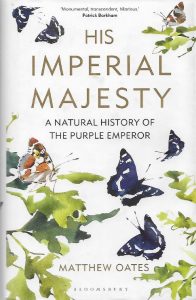Matthew Oates. 2020. His Imperial Majesty, a natural history of The Purple Emperor. London, Bloomsbury Wildlife. 416pp £20.00 HB
The author, retired from The National Trust, is the UK’s expert on the Purple Emperor, and this book reflects his particular obsession with ‘His Majesty’. The title is borrowed from the Victorian era. The sub-heading accounts for the minutiae of the species whose preferences have led Oates a merry dance amongst the woodland, scrub and farmland throughout the UK, notebook in hand over the last few decades. Oates says that the book could not be written without his involvement with the wilding project at Knepp (West Sussex), and Isabelle Tree, the co-owner of Knepp, has written a lively Introduction. Of Knepp he says it has become the foremost Purple Emperor site in Europe, and later says that a private estate in East Sussex is the best breeding ground he has ever seen. Oates has had to change his views on the habitat preference of the Purple Emperor, away from its perception as a forest species, even though he variously says in the book that it is an arboreal species and a canopy-loving species. He argues that the species is now widespread and not rare any more, and he champions the species as the National Butterfly. What about the Swallowtail, or Large Blue? Oates is quick to say that various lepidopterists are wrong or have differing opinions: Heslop, Frohawk and Pratt. Of Heslop he says it is a pity he did not publish his notes, and Oates goes on to rely heavily on Heslop’s work. As the author points out, the book is clearly written in an anthropomorphic manner with a few concessions to science, principally the reproduction of distribution maps. His penultimate chapter is on Conservation Issues, but you have to work hard to find any bullet points on how to conserve the insect, mostly focusing on sallow management. He says that he is not convinced that the species actually ‘needs some thinking and practices of contemporary nature conservation.’ That said Oates argues for a rigorous peer-reviewed scientific work on the ecology of the Purple Emperor and gives useful tips for future research topics. This book, that embodies his almost complete dedication to the species, will not do, even though the 17 chapters are packed with day to day factual ecological information from his exhaustive and laudable time in the field over the last few decades. The book is a little repetitive and could have been more tightly edited, and there are bits about Christine Keeler, and Pygmy Hippos that could have been edited out. Many lepidopterists are mentioned, but some like the Rothschilds (Charles and Miriam) are not. Miriam was also a lover of butterflies. There is a short glossary, references and further reading, but the best, previously unpublished section is the Appendix which runs for 50 pages and describes county by county, wood by wood, the varying and increasing range of the species that has not been collectively drawn together elsewhere. Excellent. The book is an interesting read and will appeal to all the followers of Purple Emperors, of which there is a fan club.
